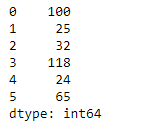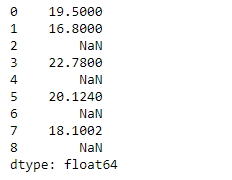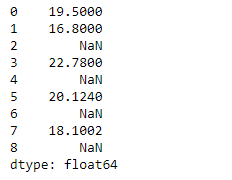Python Pandas Series.squeeze()
Python是一种进行数据分析的伟大语言,主要是因为以数据为中心的Python包的奇妙生态系统。Pandas就是这些包中的一个,它使导入和分析数据变得更加容易。
Pandas系列是一个带有轴标签的一维ndarray。标签不需要是唯一的,但必须是一个可散列的类型。该对象支持基于整数和标签的索引,并提供了大量的方法来执行涉及索引的操作。
Pandas Series.squeeze()函数将一维轴对象挤压成标量。单一元素的系列或DataFrames被挤压成标量。具有单列或单行的DataFrames被挤压成一个系列。否则该对象将保持不变。
语法: Series.squeeze(axis=None)
参数:
axis :要挤压的特定轴。默认情况下,所有长度为1的轴都被挤压了。
返回:挤压轴或所有轴后的投影。
示例#1 :使用Series.squeeze()函数将给定数列的单个元素挤压成标量。
# importing pandas as pd
import pandas as pd
# Creating the Series
sr = pd.Series([100, 25, 32, 118, 24, 65])
# Print the series
print(sr)
输出 :

让我们把这个数列转换为只包含那些能被13整除的元素的方式。
# Keep only those elements which are divisible by 13
sr_temp = sr[sr % 13 == 0]
# Let's print the series
print(sr_temp)
输出 :

现在我们将使用Series.squeeze()函数将给定的系列对象缩减为一个标量。
# squeeze the series to scalar
sr_temp.squeeze()
输出 :

正如我们在输出中看到的,Series.squeeze()函数已经成功地将给定的数列还原为标量。
例子#2 :使用Series.squeeze()函数来挤压给定的系列对象。
# importing pandas as pd
import pandas as pd
# Creating the Series
sr = pd.Series([19.5, 16.8, None, 22.78, None, 20.124, None, 18.1002, None])
# Print the series
print(sr)
输出 :

现在我们将使用Series.std()函数来挤压给定的系列对象。
# squeeze the series to scalar
sr_temp.squeeze()
输出 :

正如我们在输出中看到的,Series.squeeze()函数返回了同一个系列对象,因为在给定的系列对象中存在不止一个元素,因此它不能被挤压成一个标量值。
 极客教程
极客教程